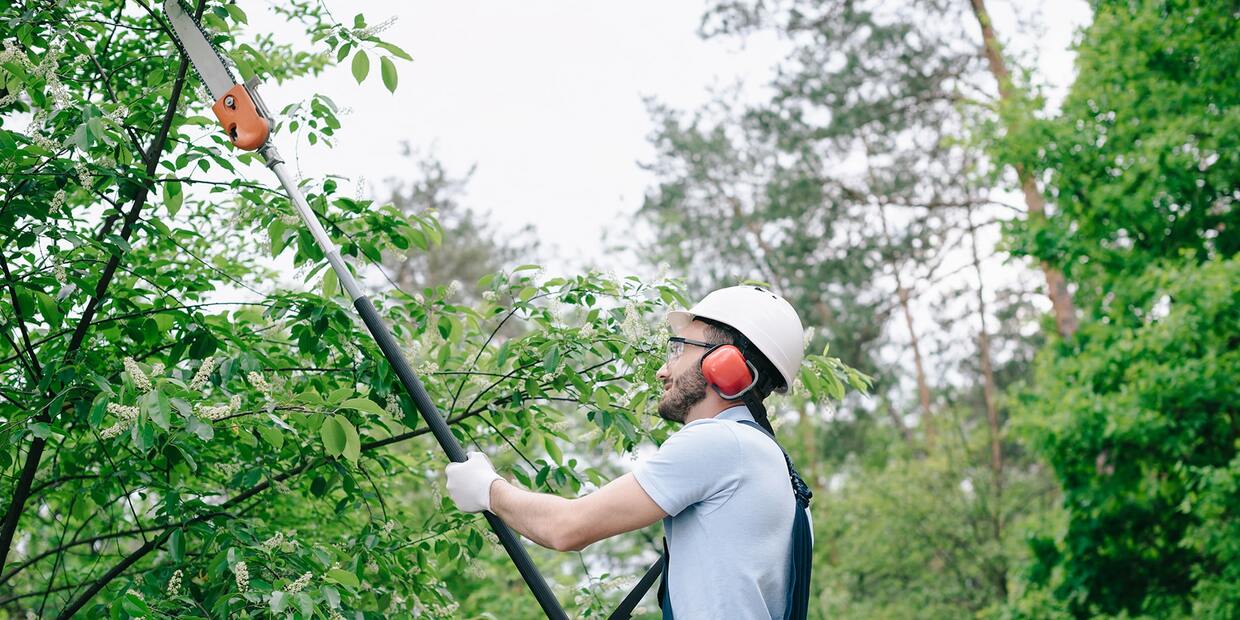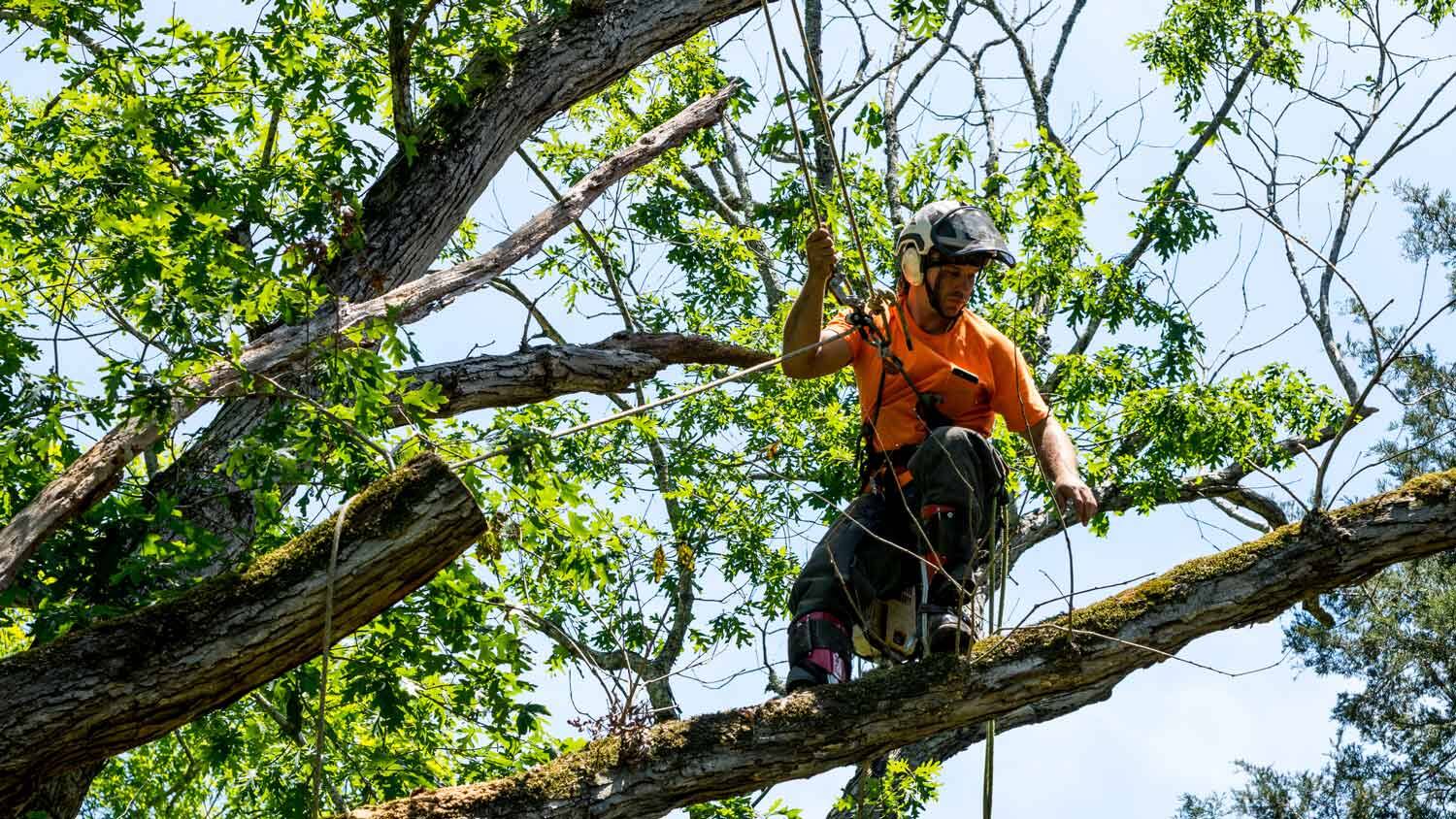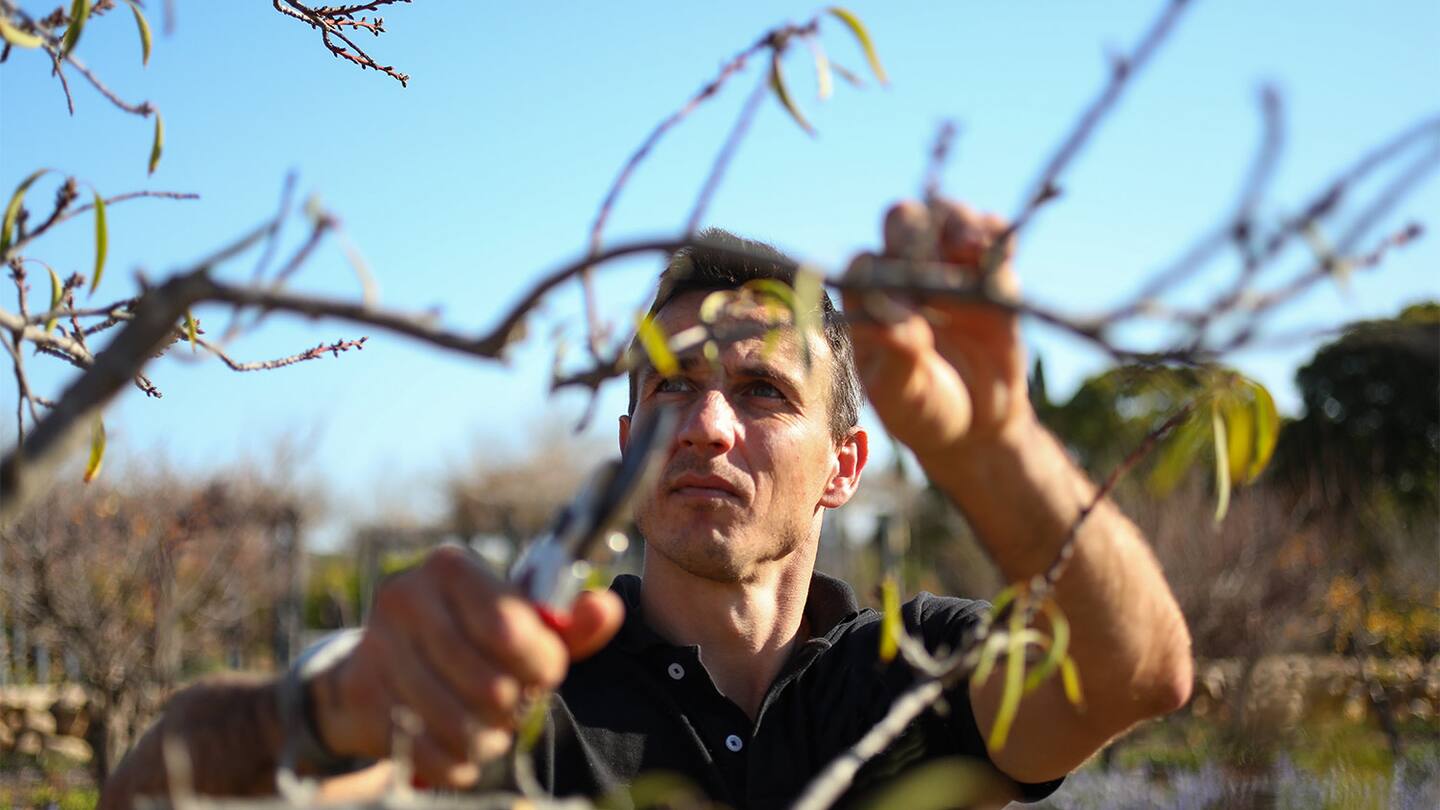Home>Gardening Techniques>Plant Care>How To Trim Citrus Trees


Plant Care
How To Trim Citrus Trees
Published: November 8, 2023
Learn how to trim citrus trees and keep them healthy with proper plant care techniques. Ensure your citrus trees thrive with these expert tips and tricks!
(Many of the links in this article redirect to a specific reviewed product. Your purchase of these products through affiliate links helps to generate commission for Chicagolandgardening.com, at no extra cost. Learn more)
Table of Contents
- Introduction
- Tools and Materials Needed
- Step 1: Assessing the Tree’s Health
- Step 2: Choosing the Right Time to Trim
- Step 3: Preparing for Trimming
- Step 4: Trimming the Tree
- Step 5: Removing Dead or Diseased Branches
- Step 6: Shaping the Tree
- Step 7: Final Pruning Techniques
- Step 8: Cleaning Up the Area
- Conclusion
Introduction
Welcome to the world of plant care! One of the fundamental aspects of nurturing healthy and flourishing plants is proper pruning and trimming. Whether you are a seasoned plant enthusiast or just starting with your green thumb journey, learning how to trim your citrus trees is an essential skill to master.
Citrus trees, such as lemon, orange, and grapefruit, are not only beautiful additions to any garden but also provide an abundance of delicious fruits. Regular trimming not only helps maintain the tree’s shape and aesthetics but also promotes better air circulation, sunlight penetration, and overall plant health.
In this comprehensive guide, we will take you through the step-by-step process of trimming your citrus trees, covering everything from assessing the tree’s health to applying final pruning techniques. By the end of this article, you will have the knowledge and confidence to keep your citrus trees in excellent shape and maximize their fruit-bearing potential.
Before we dive into the details, it’s important to emphasize the significance of safety during the trimming process. Always wear protective gloves, goggles, and appropriate clothing, and be cautious of any potential hazards such as power lines or unstable branches.
Now, let’s gather our tools and materials and embark on this journey to master the art of trimming citrus trees!
Tools and Materials Needed
Before you start trimming your citrus trees, it’s essential to gather all the necessary tools and materials to ensure a smooth and efficient pruning process. Here are the items you’ll need:
- Pruning Shears: This is a must-have tool for trimming small branches and twigs. Look for bypass pruning shears, which have a scissor-like cutting action, making it easier to achieve clean cuts without damaging the plant.
- Loppers: For larger branches, loppers will come in handy. These long-handled pruning tools have a more powerful cutting mechanism and can handle branches up to 2 inches in diameter.
- Hand Saw: In case you encounter thicker branches that cannot be cut with pruning shears or loppers, a hand saw will be necessary. Choose a pruning saw with a curved blade and sharp teeth for efficient cutting.
- Pole Saw: If your citrus tree is tall and has branches out of reach, a pole saw can help you trim them safely from the ground. Make sure to select a high-quality pole saw with an adjustable length and a sharp cutting blade.
- Gloves: Protect your hands from thorns and sharp edges by wearing sturdy, non-slip gloves. Opt for gloves that provide both dexterity and durability.
- Eye Protection: Safety goggles or glasses are essential to shield your eyes from debris and potential injuries while trimming branches. Make sure they fit securely and provide proper coverage.
- Pruning Sealant: Although not mandatory, pruning sealant can be used to cover larger cuts or wounds on branches. This helps prevent disease and pests from entering and harming the tree.
- Bucket or Tarp: Having a bucket or tarp nearby will make it easier to collect and dispose of the pruned branches and clippings.
It’s crucial to keep your tools clean and sharp to ensure precise cuts and reduce the risk of transmitting diseases. Clean them with disinfectant after each use and sharpen blades regularly.
Now that you have all the necessary tools and materials at your disposal, it’s time to move on to the next step: assessing the health of your citrus tree.
Step 1: Assessing the Tree’s Health
Before you start trimming your citrus tree, it’s crucial to evaluate its overall health. This step will help you identify any issues that may require special attention or treatment. Here are some key factors to consider when assessing the health of your tree:
- Inspect for Diseased or Dead Branches: Examine the branches for any signs of disease, such as discoloration, wilting, lesions, or pest infestations. Additionally, look for dead branches that may hinder the tree’s growth or pose a safety hazard.
- Check for Suckers and Water Sprouts: Suckers are small shoots that grow from the tree’s base or from the rootstock. Water sprouts, on the other hand, are long, vigorous shoots that emerge from the main branches. Remove both suckers and water sprouts as they divert nutrients and energy from the main tree.
- Assess the Canopy Density: A dense and overcrowded canopy can impede airflow, sunlight penetration, and overall tree health. Look for areas with excessive foliage and consider thinning out the branches to promote better air circulation.
- Check for Crossed or Rubbing Branches: Crossed or rubbing branches can cause damage and create entry points for diseases. Identify any branches that are crossing or rubbing against each other and make a plan to remove them.
- Observe Fruit Production: Evaluate the tree’s fruit production and quality. If you notice a decline in fruit yield, it could indicate nutrient deficiencies or other underlying issues that need to be addressed.
During this assessment, make note of any specific areas or branches that require attention. This will guide you in the subsequent steps of the trimming process.
Remember, keeping your citrus tree healthy is crucial for optimal growth and fruit production. If you notice any significant issues or are uncertain about the tree’s health, it’s advisable to consult a professional arborist or horticulturist for guidance.
Now that you’ve assessed the health of your citrus tree, it’s time to move on to the next step: choosing the right time to trim.
Step 2: Choosing the Right Time to Trim
Timing is crucial when it comes to trimming citrus trees. Choosing the right time to trim ensures that you promote healthy growth, minimize stress on the tree, and maximize fruit production. Here are some guidelines to help you determine the optimal time for trimming:
- Prune during Dormant Season: The best time to trim citrus trees is during the dormant season, typically in late winter or early spring. This is when the tree is in a resting phase and has less sap flow, making it less vulnerable to stress and diseases.
- Avoid Pruning during Extreme Temperatures: It’s important to avoid pruning during periods of extreme heat or cold. Freezing temperatures can damage newly pruned branches, while excessive heat can cause stress and dehydration. Opt for mild, dry weather conditions for optimal results.
- Wait for Fruit Harvest: If your citrus tree is currently producing fruit, it’s best to wait until after the harvest to prune. Trimming while fruit is on the tree can disrupt the growth and development of the fruit, affecting its quality and quantity.
- Consider Specific Citrus Varieties: Different citrus varieties may have specific pruning requirements. Research the specific needs of your citrus tree variety to ensure you are pruning at the ideal time to promote its individual growth habits and maximize its potential.
It’s important to note that light pruning, such as removing dead or damaged branches, can be done throughout the year as necessary. However, major pruning or shaping should be reserved for the dormant season to minimize stress on the tree.
By choosing the right time to trim your citrus tree, you are setting the stage for optimal growth and fruit production. Now that you have determined the ideal timing, it’s time to prepare for the trimming process.
Step 3: Preparing for Trimming
Before you begin the actual trimming process, it’s crucial to make the necessary preparations. Taking the time to gather the right tools, ensure your safety, and plan your approach will make the trimming process smoother and more efficient. Here are some steps to help you prepare for trimming your citrus tree:
- Gather Your Tools: Ensure that you have all the necessary tools and equipment at hand, as mentioned in the previous section. Check the condition of your tools and make any necessary repairs or replacements.
- Wear Protective Gear: Before you start trimming, put on protective gear to safeguard yourself from potential injuries. This includes gloves, eye protection, and appropriate clothing, such as long sleeves and pants.
- Disinfect Your Tools: Clean and disinfect your tools to prevent the spread of diseases from one branch to another. Use a solution of 10% bleach or rubbing alcohol to wipe down the blades of your pruning shears, loppers, and saws.
- Create a Trimming Plan: Take a step back and assess your citrus tree once again. Identify the branches that need to be trimmed and establish a plan of action. Start with dead or diseased branches, followed by any crossed or rubbing branches, and then focus on overall shaping.
- Visualize Your Tree’s Shape: Consider the desired shape and size of your citrus tree. Visualize how you want it to look after trimming, keeping in mind factors such as aesthetics, sunlight penetration, and airflow. This will guide you in making the right cuts.
- Prepare for Disposal: Arrange a bucket or tarp to collect the pruned branches and clippings. This will make cleanup easier and help prevent any damage to the surrounding area. Consider composting the organic material or disposing of it properly.
By adequately preparing for trimming, you set yourself up for success and ensure a more efficient and safe process. Once you’ve made the necessary preparations, it’s time to move on to the actual trimming of your citrus tree.
Step 4: Trimming the Tree
Now that you’ve assessed the health of your citrus tree, chosen the right time to trim, and made the necessary preparations, it’s time to start trimming. Follow these steps to properly trim your citrus tree:
- Start with Dead and Diseased Branches: Begin by identifying and removing any dead or diseased branches. Use pruning shears or loppers to make clean cuts at the base of the branch, just outside the branch collar. This helps prevent any potential spread of disease and promotes overall tree health.
- Remove Suckers and Water Sprouts: Next, remove any suckers or water sprouts emerging from the base or main branches of the tree. These shoots divert energy from the main tree and can hinder its growth. Use pruning shears to cut them as close to the base as possible.
- Thin Out Overcrowded Branches: Evaluate the density of the branches in the canopy. Identify any areas that are overcrowded or crossing branches. Use pruning shears or loppers to thin out the branches, creating better air circulation and allowing more sunlight to reach the inner parts of the tree.
- Trim Back Long or Leggy Branches: If you notice any branches that are excessively long or leggy, consider trimming them back to promote a more balanced and compact shape. Make the cut just above a bud or junction to encourage new growth in the desired direction.
- Shape the Tree: As you trim, keep the desired shape of the tree in mind. Aim for a balanced structure with an open center, allowing light to reach all parts of the tree. Step back occasionally to evaluate the overall shape and adjust the pruning as needed.
Throughout the trimming process, remember to make clean cuts at the appropriate locations. Avoid leaving stubs or tearing the bark, as this can lead to infections and weaken the tree. Take your time and be mindful of your cuts, ensuring they are made with precision and care.
As you trim, periodically clean the blades of your tools to prevent the spread of diseases between branches. Disinfect them with a solution of 10% bleach or rubbing alcohol before moving on to different areas of the tree.
Continue to the next step: removing dead or diseased branches.
Step 5: Removing Dead or Diseased Branches
After completing the general trimming of your citrus tree, it’s time to focus on removing any dead or diseased branches. This step is crucial for maintaining the health and vitality of your tree. Follow these steps to effectively remove dead or diseased branches:
- Identify Dead or Diseased Branches: Carefully inspect the branches of your citrus tree and look for branches that show signs of disease, such as discoloration, fungal growth, or wilting leaves. Also, look for branches that are entirely dead, as they won’t contribute to the tree’s growth or fruit production.
- Make Clean Cuts: Using clean pruning shears or loppers, make clean cuts at the base of the diseased or dead branch, just outside the branch collar. The branch collar is the swollen area at the base of the branch where it connects to the main trunk. Cutting just outside the branch collar helps promote proper healing and prevents the entry of pests or diseases.
- Dispose of Removed Branches: Collect the removed branches and dispose of them properly. Avoid leaving the pruned branches near the tree as they can attract pests or contribute to the spread of diseases. Consider composting the organic material or contacting your local waste management facility for disposal guidelines.
- Disinfect Your Tools: To prevent the spread of diseases, it’s essential to disinfect your tools after removing each diseased branch. Use a solution of 10% bleach or rubbing alcohol and wipe down the blades of your pruning shears or loppers. This helps ensure that you don’t transfer any pathogens to healthy branches.
- Monitor for New Signs of Disease: After removing the dead or diseased branches, keep a close eye on your citrus tree for any new signs of disease. Regularly inspect the leaves, branches, and trunk for any changes in color, texture, or overall health. If you notice any concerning symptoms, consult a professional arborist or horticulturist for further guidance.
Removing dead or diseased branches is essential for maintaining the overall health and vigor of your citrus tree. By promptly addressing and removing these problem areas, you ensure that the tree can focus its energy on healthy growth and fruit production.
With the dead and diseased branches removed, you can now move on to the next step: shaping the tree to achieve the desired appearance.
Step 6: Shaping the Tree
Now that you have completed the essential steps of assessing the tree’s health, choosing the right time to trim, preparing for trimming, trimming the tree, and removing dead or diseased branches, it’s time to focus on shaping your citrus tree. Shaping plays a crucial role in maintaining an aesthetically pleasing and well-balanced appearance. Follow these steps to shape your citrus tree:
- Visualize the Desired Shape: Step back and visualize the shape you want your citrus tree to have. Consider factors such as the space available, access to sunlight, and the tree’s natural growth habit. Aim for a shape that promotes good air circulation, sunlight penetration, and easy maintenance.
- Identify Overlapping or Crossing Branches: Inspect the tree closely for any branches that overlap or cross each other. These branches can create rubbing or friction, potentially leading to damage and disease. Identify these areas and selectively remove the necessary branches to alleviate the problem.
- Create an Open Center: Citrus trees, particularly those trained in the central leader or modified central leader style, benefit from an open center structure. Remove any excess branches or suckers that are growing towards the center, allowing the tree’s crown to have an open and well-ventilated form.
- Maintain a Balanced Canopy: Ensure that the tree’s canopy is evenly distributed, with branches extending in different directions. Trim back excessively long or leggy branches to encourage a more compact and proportionate shape.
- Consider the Tree’s Height: Take into account the height of your citrus tree and trim the uppermost branches to prevent the tree from becoming too top-heavy. This aids in maintaining stability and prevents the risk of branches breaking due to excessive weight.
- Follow Natural Growth Patterns: Work with the natural growth patterns of the tree and avoid excessive pruning that can harm its overall health. The goal is to shape the tree while allowing it to maintain its natural form and vigor.
Remember to step back periodically during the shaping process to assess and fine-tune the tree’s appearance. Be patient and make small, intentional cuts to achieve the desired shape gradually. It’s important to strike a balance between aesthetic appeal and the tree’s overall health.
With the shaping complete, you’re almost done with the trimming process. Now it’s time for the final pruning techniques to add those finishing touches.
Step 7: Final Pruning Techniques
As you near the end of the trimming process for your citrus tree, it’s time to apply some final pruning techniques to refine its shape and ensure optimal growth and fruit production. Follow these steps for the final touches:
- Remove Small Suckers and Water Sprouts: Scan the tree once more for any remaining small suckers or water sprouts that may have been missed during previous trimming. Use pruning shears to eliminate these shoots to maintain the tree’s energy focus on healthy growth.
- Trim Branch Tips: To encourage branching and bushier growth, consider trimming the tips of lateral branches. Make clean cuts just above a bud or junction to invigorate growth in the desired direction.
- Stay Clear of Major Pruning: At this stage, avoid any major pruning that may remove a significant portion of the tree’s foliage or branches. Major pruning is best done during the dormant season to minimize stress on the tree.
- Inspect for Uneven Growth: Look for any areas where the tree’s growth appears uneven or imbalanced. Trim back excessive growth in these areas to promote a more uniform shape and distribute resources evenly.
- Consider Thinning Out Fruits: If your citrus tree has a heavy fruit load, it may be necessary to thin out some of the fruits. Remove excess fruits to ensure proper spacing and allocation of nutrients, promoting better fruit development and preventing branches from becoming weighed down and potentially breaking.
- Step Back and Assess the Tree: Once you’ve completed the final pruning techniques, step back and assess the appearance of your citrus tree. Check for any areas that may still require minor adjustments or refinements.
Remember to make clean cuts just above buds or junctions and avoid leaving stubs. Additionally, continue disinfecting your pruning tools after each cut to prevent the spread of diseases.
With the final pruning techniques applied, you’ve successfully completed the trimming process for your citrus tree. Now, it’s time to clean up the area and ensure a tidy and safe environment.
Step 8: Cleaning Up the Area
Congratulations on completing the trimming process for your citrus tree! Now that the pruning is done, it’s important to clean up the area to maintain a tidy and safe environment. Follow these steps to effectively clean up after trimming:
- Collect Pruned Branches and Clippings: Gather all the pruned branches and clippings that were collected during the trimming process. Place them in a bucket or tarp to contain the debris and make it easier for disposal.
- Dispose of the Debris Properly: Properly dispose of the pruned branches and clippings according to your local waste management guidelines. Consider composting the organic material if possible, or contact your local recycling center for guidance.
- Sweep or Rake the Area: Use a broom or rake to remove any small twigs, leaves, or debris from the ground around the tree. This helps prevent pests and diseases from lingering in the area and promotes a clean and healthy environment.
- Clean and Store Your Tools: Take the time to clean your pruning tools thoroughly to remove any sap or residue. Disinfect them with a solution of 10% bleach or rubbing alcohol and allow them to dry. Store the tools in a clean and dry area for future use.
- Inspect the Surrounding Area: Once the immediate area around the tree is clean, inspect the surrounding area for any remaining debris or hazards. This includes checking for branches or twigs that may have fallen outside the immediate vicinity of the tree.
- Final Check on the Tree: Take a final look at the tree to ensure that no loose or hanging branches remain. If you notice any, perform the necessary trimming to remove them and prevent potential accidents or damage.
By properly cleaning up after trimming, you not only maintain a neat and organized garden but also reduce the risk of pests, diseases, and accidents. Additionally, storing your tools properly helps prolong their lifespan and keeps them in good working condition for future use.
With the area cleaned up, you have successfully completed the entire trimming process for your citrus tree! By following these steps and applying proper pruning techniques, you have taken a significant step towards promoting the health, beauty, and productivity of your tree.
Remember to regularly monitor your citrus tree’s health, assess the need for future pruning, and continue providing it with the care it requires to thrive. Happy trimming and may your citrus tree flourish!
Conclusion
Trimming your citrus trees is an important aspect of plant care that promotes healthy growth, optimal fruit production, and overall tree vigor. By following the step-by-step process outlined in this guide, you’ve gained the knowledge and skills to effectively trim and shape your citrus tree.
Starting with assessing the tree’s health and choosing the right time to trim, you took the necessary precautions to ensure the well-being of your tree. By gathering the required tools and materials and making proper preparations, you set yourself up for a successful trimming process.
Throughout the trimming process, you followed the guidelines for removing dead or diseased branches, shaping the tree, and applying final pruning techniques. These steps allowed you to achieve the desired form, ensure proper airflow and sunlight penetration, and improve the overall aesthetics of your citrus tree.
Lastly, you learned the importance of cleaning up the area after trimming, disposing of debris correctly, and properly maintaining your tools for future use.
Remember that each citrus tree is unique, and it’s important to adapt these guidelines to the specific needs and growth habits of your tree. Regular observation and monitoring of your tree’s health will allow you to address any issues promptly and make informed decisions about future pruning and care.
With your newly acquired knowledge and skills, you can confidently maintain the health and beauty of your citrus trees. Enjoy the process of nurturing and caring for your trees, and may they provide you with bountiful harvests and the joy of a thriving garden!










